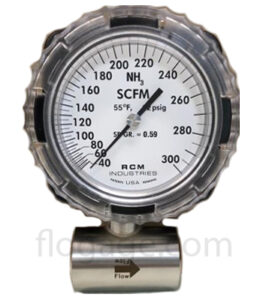RCM Ammonia Gas Flow Meters
RCM Series 7000 and RCM Series 8000
The RCM gas flow meters are well suited to monitoring ammonia gas flow rates. These meters plumb directly into the pipelines and require no external power connections. Use these meters to determine the air consumption of tools for improved accounting and increased efficiency. The Flo-Gage flow meter has been developed for industrial applications where durability and reliability are important considerations in the monitoring of flow. The Flo-Gage has accuracy for most industrial processes and is particularly suited for applications where compactness, low cost, minimal maintenance and resistance to accidental damage are important factors. Other compressed gases can be monitored as well. Common gases monitored include nitrogen, oxygen, argon, carbon dioxide, natural and LP gases.
- 316SS Construction (brass free)
- EPR Seals and Gasket Case
- Threaded Connections (Series 7000) from 1/4″ to 3″ in NPT or BSP.
- Wafer Style (Series 8000) from 1/2″ to 8″.
Configured Specifically for Ammonia Gas Service
Ammonia gas is used in distillation plants and as a cooling agent. Our Ammonia gas flow meters offer all stainless steel construction to withstand the harsh environment. EPR seals and a gasketed case are standard features for additional protection. The Ammonia gas flow meter has been developed for industrial applications where durability and reliability are important considerations in the monitoring of ammonia gas flow.
Selecting Meters for Gas Service
- The Flo-Gage can be used to measure flow rates of various gases such as air, nitrogen, oxygen, carbon dioxide, hydrogen, propane, methane (natural gas), argon, helium, sulfur dioxide, etc.
- For best accuracy, select a flow rate which will permit normal operation in the upper half of the meter scale.
- To choose the proper meter, select pipe size and full scale flow rate from the chart of “Standard Flow Rates and Body Sizes“.
- To insure satisfactory operation, pressure should be not less than 10 psig at the meter inlet.
Minimum Flow Rates
The minimum flow rate which can be read is approximately 15% of the full scale flow rate for all meters. For best accuracy, select a flow rate which will permit normal operation in the upper half of the meter scale.
lnstallation Guidelines
Provide 10 diameters of straight pipe in front of meter. Install control valves or solenoid valves downstream of meter if possible.
Services Not Recommended
Flo-Gages are not recommended for the following kinds of service:
- Resins, paints or monomers which can form solid deposits in the piping system.
- “Super-solvents” which attack most available elastomers.
- Sulfuric acid in any concentration.
- Foams which tend to have inconsistent densities.
- Toxic substances requiring hermetically sealed enclosures.
- Fluids with viscosity above 500 centipoise.
- Pumping systems using piston pumps which produce non-steady flow conditions.
- Gravity-fed systems having less head than the pressure loss across the meter at normal operating conditions.
| Specifications | Standard | Optional |
|---|---|---|
| Series 7000 | FNPT (threaded) Standard | |
| Series 8000 | Wafer unit mount between 150 or 300 class flanges. | |
| Housing | UV Stabilized Polycarbonate | Aluminum |
| Body | Bronze | Monel / 316SS |
| Bellows | Bronze | Monel / 316SS / Inconel |
| Seals | Buna N | Viton / EPR / Teflon |
| Crystal | Polycarbonate | Glass |
| Gear Movement | Bronze | 316SS |
| Accuracy | u00b1 3% F.S. | u00b1 3% F.S. |
| Repeatability | u00b1 1% F.S. | u00b1 1% F.S. |
| Maximum Pressure | 180 psig (12.6 kg/cm2) | 400 psig (28.1 kg/cm2) |
| Minimum Pressure | 10 psig (0.67kg/cm2) | 10 psig (0.67kg/cm2) |
| Maximum Temperature | 212 F (100 C) | 350 F (177 C) |
| Minimum Temperature | -30 F (-34 C) | -80 F (-62 C) |

